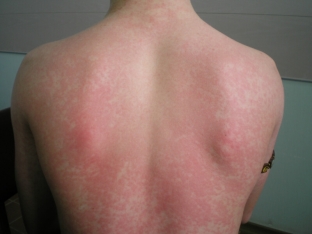Until recently, the cause of toxicoderma was considered to be the body's reaction to drugs, but now it can be provoked by household chemicals and some chemicals that enter the body with food.
Toxicoderma, or toxic-allergic dermatitis is an acute inflammation of the skin, and sometimes mucous membranes, developing under the influence of an allergenic, toxic or toxic-allergic factor that enters the body through the respiratory tract, digestive tract or intravenous, subcutaneous, intramuscular injection.
The main causes of toxicoderma. Mechanism of development of toxicoderma
For the first time, the term "toxicoderma" was introduced by G. Yadasson, who noted the predominantly medical origin of this disease. Recently, the problem of toxicoderma has aggravated, which is associated with the expanding introduction of household chemicals, environmental degradation, and the emergence of new drugs. In the etiology of toxicoderma, the main role is played by exogenous causes, less often endogenous.
Causes of toxicoderma:
- exogenous causes of toxicoderma include drugs, food products, industrial and household chemicals that enter the human body through the digestive and respiratory tract. In addition, drugs can cause toxicoderma by any route of administration;
- endogenous causes of toxicoderma are autointoxications with unusual metabolic products that appear in the body as a result of dysfunction of the digestive tract, liver, kidneys, thyroid gland, neoplasms, metabolic diseases, and helminthic invasions.
Drug toxicoderma can occur as a result of prolonged use of a drug and is a variant of drug disease. What medications often cause toxicoderma, read further on estet-portal.com. The cause of toxicoderma can be a variety of drugs.
What drugs can cause toxicoderma?
Drug toxicoderma occurs in 2-3% of hospitalized patients and accounts for 19% of all drug treatment complications.
For many commonly used drugs, the incidence of toxicoderma exceeds 1%. As a rule, it is impossible to predict the development of toxic-allergic reactions.
The risk of toxicoderma is considered high (3-5%) when treated with penicillins, carbamazepine, allopurinol, gold preparations.
Moderate risk is present with sulfonamides, oral antihyperglycemic agents, diuretics, non-steroidal anti-inflammatory drugs, isoniazid, chloramphenicol, erythromycin, streptomycin. Barbiturates, benzodiazepines, phenothiazines, and tetracyclines are rarely the cause of toxicoderma.
What body reactions are triggered by the development of toxicoderma?
The pathogenesis of toxicoderma is based on an allergic reaction. In most cases, we are talking about drug toxicoderma, which is a consequence of the sensitizing effect of the drug.

In the pathogenesis of drug toxicoderma, toxic and allergic components are often combined, which leads to the development of diverse lesions of the skin, mucous membranes, nervous and vascular systems, and internal organs characteristic of a drug disease.
The allergen, penetrating into the cells of the skin and other tissues, comes into contact with the functional structures of the cytoplasm (nucleoproteins, mitochondria).
Immune mechanisms of drug toxicoderma:
- ; cytotoxic allergic reactions;
- immunocomplex allergic reactions;
- delayed allergic reactions.
- Among the non-immune mechanisms of drug toxicoderma, it should be noted:
hereditary enzyme deficiency;
- individual intolerance to the drug;
- local irritant effect of the drug;
- cumulation (eg, melanosis with gold or amiodarone treatment);
- combined action of the drug and ultraviolet radiation (phototoxic reactions).
- Skin damage can occur as a result of drug suppression of enzyme systems, toxic damage to tissues, blood vessels, and changes in the body's reactivity. Contribute to sensitization transferred and existing allergic diseases, hereditary predisposition to allergic processes. Read about the symptoms of toxicoderma, diagnosis and treatment of toxicoderma in our following articles.






Add a comment